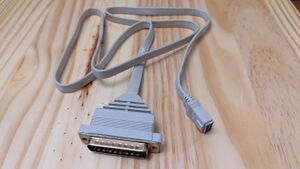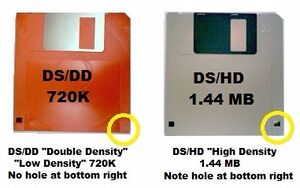TPDD: Difference between revisions
No edit summary |
|||
| (88 intermediate revisions by the same user not shown) | |||
| Line 1: | Line 1: | ||
= | =Tandy Portable Disk Drive= | ||
There were two versions of the Tandy Portable Disk Drive. Both were very similar. The | There were two versions of the original Tandy Portable Disk Drive, "26-3808 Tandy Portable Disk Drive" or now called "TPDD1", and "26-3814 Tandy Portable Disk Drive 2" or "TPDD2". Both were very similar. | ||
The original TPDD1 is a re-branded Brother FB100. In fact the Brother FB100 was sold under several names. At least: | |||
:Brother FB100 | |||
:TANDY Portable Disk Drive | |||
:knitking FDD19 | |||
:Purple Computing D103 | |||
The TPDD2 was also sold under multiple names. At least: | |||
:TANDY Portable Disk Drive 2 | |||
:XOB Disc-88 | |||
==Common features of both versions== | ==Common features of both versions== | ||
| Line 9: | Line 19: | ||
:Drive is single-sided. The disks may be single or double-sided, but the drive only uses one side. | :Drive is single-sided. The disks may be single or double-sided, but the drive only uses one side. | ||
=Documentation= | |||
==Tandy Portable Disk Drive== | ==Tandy Portable Disk Drive== | ||
100K | 100K | ||
:[ | :[https://archive.org/details/TandyPortableDiskDriveOperationManual26-3808 Operation Manual] | ||
:[https://archive.org/details/ | :[https://archive.org/details/tandy-service-manual-26-3808-s-software-manual-for-portable-disk-drive Software Manual] | ||
:[https://archive.org/details/ | :[https://archive.org/details/tandy-portable-disk-drive-service-manual-26-3808 Service Manual] | ||
:[ | :[http://www.club100.org/library/sup/07.txt TPDD1 bootstrap procedure] | ||
<!-- :[http://bitchin100.com/wiki/index.php?title=Base_Protocol Command Reference] --> | |||
:[[File:TPDD1_ROM.zip]] - dump of the 4k rom built into the HD63A01V1 cpu | |||
:ROM is also identical in Brother FB-100, KnitKing FDD19, and Purple Computing D103 | |||
==Tandy Portable Disk Drive 2== | ==Tandy Portable Disk Drive 2== | ||
200K in the form of 2 100K banks | 200K, in the form of 2 100K banks | ||
:[https://archive.org/details/Portable_Disk_Drive_2_Operation_Manual_1986_Tandy TPDD2 Operation Manual] | |||
:[https://archive.org/details/tpdd-2-service-manual TPDD2 Service Manual] | |||
:[http://www.club100.org/library/sup/08.txt TPDD2 bootstrap procedure] | |||
<!-- :[http://bitchin100.com/wiki/index.php?title=TPDD-2_Sector_Access_Protocol TPDD2 Sector Access] --> | |||
:[ | :[[File:TPDD2_ROM.zip]] - dump of the 4k rom built into the HD63A01V1 cpu | ||
=Parts= | =Parts= | ||
| Line 30: | Line 49: | ||
===Cable=== | ===Cable=== | ||
The "RS-232C" interface to the TPDD is actually 5v TTL (0v to +5v), while RS-232 serial ports use -12v to +12v. So the cable isn't just a cable, it has electronics inside the DB25 plug to convert the signal levels between TTL and RS-232. | |||
You can't buy the original special cable any more, but you can [https://github.com/bkw777/TPDD_Cable build one], or buy one from [https://www.arcadeshopper.com/wp/?page_id=11#!/Special-serial-cable-for-Tandy-Portable-Disk-Drive-and-Tandy-Portable-Disk-Drive-2/p/144969001/category=28313042 ArcadeShopper] (picture is outdated, the cables are the same as the one on github), or [https://www.soigeneris.com/tpdd2_cable SoiGeneris]. | |||
Pinout | Pinout | ||
| Line 52: | Line 72: | ||
:6 TXD | :6 TXD | ||
:7 RXD | :7 RXD | ||
:8 | :8 EB+ (External Battery +4.8 to +6v) (Only on TPDD2, n/c on TPDD1) | ||
[[File:TPDD2 original cable.jpg|thumb|none]] | |||
<!-- save until duplicated somewhere | |||
:Assembly: | :Assembly: | ||
:*Solder all components to pcb per the render pics. | :*Solder all components to pcb per the render pics. | ||
:*Cut the | :*Pull the two un-soldered pins from the top of the socket and discard. | ||
:*Put 2 to 3 | :*Cut the 9-pin plug off the serial cable. Strip the outer sheath back 1 to 2 inches. Strip each wire 1/8". | ||
:* | :*Put 2 to 3 inches of 1/2" diameter heat shrink on the serial cable. (don't shrink yet) | ||
:* | :*Identify which color wires go to which pins on the DB25 plug. | ||
:*Add some hot-glue around the soldered wires where they meet the pcb | ::Find pin 2 on the db25 | ||
::Find which color wire goes to pin 2 using a DMM continuity tester | |||
::Repeat for all the numbered holes on the PCB: 2,3,4,5,6,7,20 | |||
::Cut any left-over wires short right at the cable sheath. | |||
:*Solder the wires to their matching numbered holes, with the wires on the top side (without the transistors). | |||
:*Put some hot-glue on the top side of the pcb in the "dog bone", press the end of the cable into the glue, and secure to the pcb with a zip-tie. | |||
:*Add some hot-glue around the soldered wires where they meet the pcb to immobilize them. | |||
:*Slide the heat-shrink up over the pcb and shrink. | :*Slide the heat-shrink up over the pcb and shrink. | ||
<gallery> | <gallery mode="packed-hover"> | ||
TPDD_Cable_1.jpg | |||
TPDD_Cable_2.jpg | |||
TPDD_BKW_4_3.png | TPDD_BKW_4_3.png | ||
TPDD_BKW_4_4.png | TPDD_BKW_4_4.png | ||
| Line 143: | Line 113: | ||
TPDD_BKW_4_20.jpg | TPDD_BKW_4_20.jpg | ||
</gallery> | </gallery> | ||
[[TPDD:Other_Cable_Designs]] | |||
--> | |||
=Software= | =Software= | ||
Software related to these drives can be broken into 2 main categories, [[TPDD_client|clients]] and [[TPDD_server|servers]]. | |||
TPDD | |||
A [[TPDD_client|TPDD client]] (aka dos) is software that uses a TPDD drive. This includes TS-DOS, and the program called "Floppy" which came on the special disk that came with the TANDY versions of the drives. | |||
A [[TPDD_server|TPDD server]] (aka emulator) is software that pretends to BE a TPDD drive. This includes LaddieAlpha, dl2, and others. | |||
=Misc Related Info= | |||
Low-profile DIP switch that fits under the cover on the bottom, which can be installed on Brother FB-100, KnitKing FDD19, or Purple Computing D103 to give access to all possible drive operation modes like TPDD1.<br> | |||
https://www.digikey.com/en/products/detail/cui-devices/DS04-254-2L-04BK/11310925 | |||
TS-DOS implements an extension to the TPDD protocol to provide subdirectories.<br> | |||
A real TPDD or TPDD2 doesn't support this, but some TPDD emulators do (NADSBOX, LaddieAlpha, dl2, PDDuino, at least) | |||
:[http://bitchin100.com/wiki/index.php?title=Desklink/TS-DOS_Directory_Access TS-DOS Directories] | |||
TPDD uses standard 720k DD 3.5" disks, but uses a format that is incompatible with modern pc drive controllers.<br> | |||
Normal MS-DOS formatted disks are written with MFM encoding, while the TPDD uses FM encoding.<br> | |||
Even using special software to read non-standard track/sector formats, you can't make a normal drive & drive controller read or write FM. An old pc with an early floppy controller chip and an old 720k drive may be able to do it. | |||
To read or write a TPDD disk from a modern machine, you need a working TPDD drive, the special RS232-to-TTL level-shifting serial cable, a 9F-to-25F straight through (not null-modem) serial adapter or combination of cables & adapters, and TPDD client software to talk to the drive over the serial connection the same way the M100 does. See pdd.sh, PDD.EXE, or TpddTool.py from the TPDD clients link above. | |||
Don't use 1.44M HD disks in a TPDD. Use 720K DD disks.<br> | |||
[[File:720vs144.jpg|left|thumb]] | |||
<!-- | |||
https://www.ordersomewherechaos.com/rosso/fetish/m102/web100/docs/pdd2-sector-0.html | |||
https://www.ordersomewherechaos.com/rosso/fetish/m102/web100/docs/pdd-sector-access.html | |||
--> | |||
Latest revision as of 16:52, 6 August 2024
Tandy Portable Disk Drive
There were two versions of the original Tandy Portable Disk Drive, "26-3808 Tandy Portable Disk Drive" or now called "TPDD1", and "26-3814 Tandy Portable Disk Drive 2" or "TPDD2". Both were very similar.
The original TPDD1 is a re-branded Brother FB100. In fact the Brother FB100 was sold under several names. At least:
- Brother FB100
- TANDY Portable Disk Drive
- knitking FDD19
- Purple Computing D103
The TPDD2 was also sold under multiple names. At least:
- TANDY Portable Disk Drive 2
- XOB Disc-88
Common features of both versions
- Size, shape, weight
- Batteris: 4 x AA
- Wall power: 5.5mm x 2.1mm, 6vdc, center negative, 400ma (Tandy 26-3804)
- Media: 3.5" DD, aka "720K" diskettes (not HD 1.44M)
- Drive is single-sided. The disks may be single or double-sided, but the drive only uses one side.
Documentation
Tandy Portable Disk Drive
100K
- File:TPDD1 ROM.zip - dump of the 4k rom built into the HD63A01V1 cpu
- ROM is also identical in Brother FB-100, KnitKing FDD19, and Purple Computing D103
Tandy Portable Disk Drive 2
200K, in the form of 2 100K banks
- File:TPDD2 ROM.zip - dump of the 4k rom built into the HD63A01V1 cpu
Parts
Belt
Standard size code: FRW-8.5
Search "FRW 8.5 belt" on Google or ebay
Cable
The "RS-232C" interface to the TPDD is actually 5v TTL (0v to +5v), while RS-232 serial ports use -12v to +12v. So the cable isn't just a cable, it has electronics inside the DB25 plug to convert the signal levels between TTL and RS-232.
You can't buy the original special cable any more, but you can build one, or buy one from ArcadeShopper (picture is outdated, the cables are the same as the one on github), or SoiGeneris.
Pinout
+------------------------------------------------+ | | | | | RS-232C | | ___ | | +--+ +--+ +-----+ | | | 7 5 3 1 | | (o) | | | | 8 6 4 2 | | | | | +---------+ +-----+ | +------------------------------------------------+
- 1 GND
- 2 CTS
- 3 DTR
- 4 RTS
- 5 DSR
- 6 TXD
- 7 RXD
- 8 EB+ (External Battery +4.8 to +6v) (Only on TPDD2, n/c on TPDD1)

Software
Software related to these drives can be broken into 2 main categories, clients and servers.
A TPDD client (aka dos) is software that uses a TPDD drive. This includes TS-DOS, and the program called "Floppy" which came on the special disk that came with the TANDY versions of the drives.
A TPDD server (aka emulator) is software that pretends to BE a TPDD drive. This includes LaddieAlpha, dl2, and others.
Misc Related Info
Low-profile DIP switch that fits under the cover on the bottom, which can be installed on Brother FB-100, KnitKing FDD19, or Purple Computing D103 to give access to all possible drive operation modes like TPDD1.
https://www.digikey.com/en/products/detail/cui-devices/DS04-254-2L-04BK/11310925
TS-DOS implements an extension to the TPDD protocol to provide subdirectories.
A real TPDD or TPDD2 doesn't support this, but some TPDD emulators do (NADSBOX, LaddieAlpha, dl2, PDDuino, at least)
TPDD uses standard 720k DD 3.5" disks, but uses a format that is incompatible with modern pc drive controllers.
Normal MS-DOS formatted disks are written with MFM encoding, while the TPDD uses FM encoding.
Even using special software to read non-standard track/sector formats, you can't make a normal drive & drive controller read or write FM. An old pc with an early floppy controller chip and an old 720k drive may be able to do it.
To read or write a TPDD disk from a modern machine, you need a working TPDD drive, the special RS232-to-TTL level-shifting serial cable, a 9F-to-25F straight through (not null-modem) serial adapter or combination of cables & adapters, and TPDD client software to talk to the drive over the serial connection the same way the M100 does. See pdd.sh, PDD.EXE, or TpddTool.py from the TPDD clients link above.
Don't use 1.44M HD disks in a TPDD. Use 720K DD disks.
